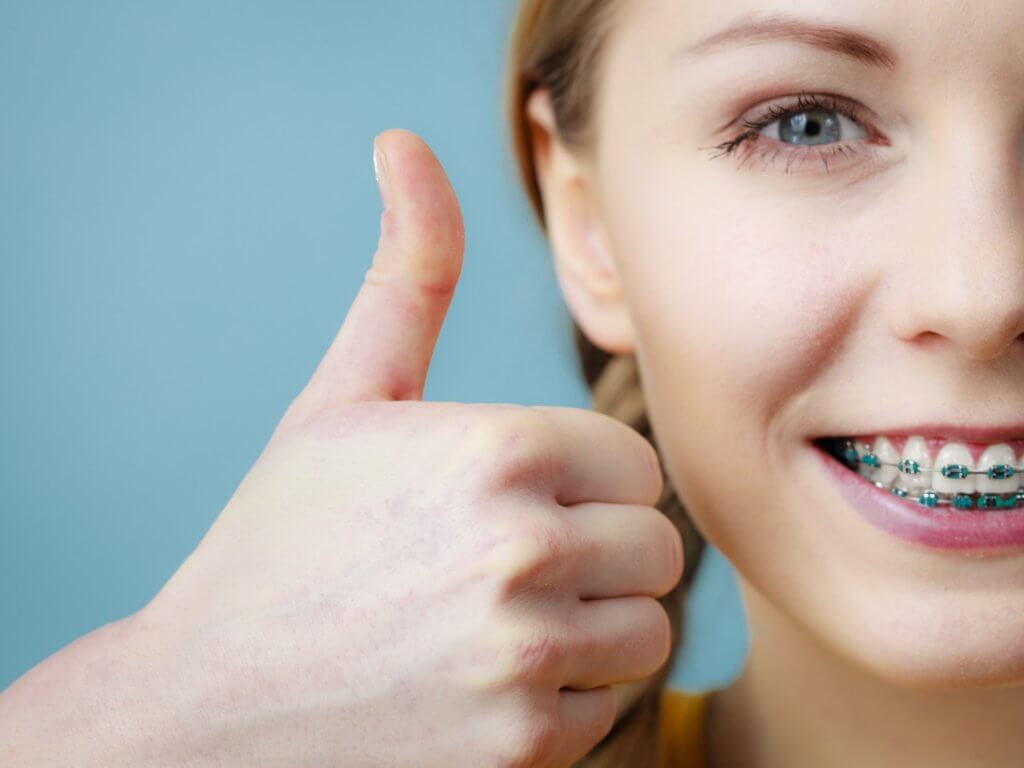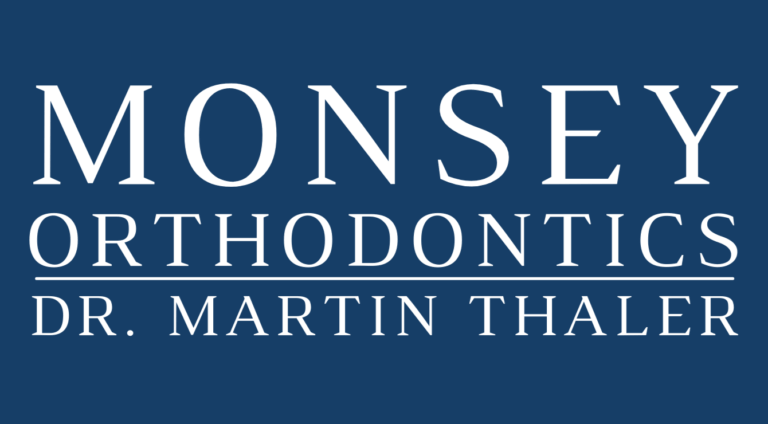treatments
braces
Traditional metal braces are the most common type of braces used today. They are smaller and more comfortable than ever before. The metal braces used at Monsey Orthodontics are constructed of high-grade metal alloys that allow a significant improvement in both comfort and efficiency when compared to older generation braces.
With metal braces, you have the option of adding colored elastics (rubber bands) for a more unique and colorful smile. You can pick and choose both your color and pattern at each visit.

PHASE I ORTHODONTICS / BRACES
What is Phase I Treatment or Early Treatment?
Early Treatment typically begins around age eight. The goal of Phase I treatment is to correct the skeletal growth of the jaw, and other bite issues. It also assist in creating adequate space for permanent teeth to come in properly, and thus lessening the chance of needing permanent teeth extracted in the future due to space issues.
Some of these issues are much easier to correct when your child is younger due to the pliability of bone, and the ability of correcting the eruption pathway of teeth before they erupt in the incorrect space. As your child grows, their bone gets harder, and can be more difficult to change. Phase I treatment is all about preventing more severe problems down the road. It allows the orthodontist to control the eruption of the permanent teeth and the growth of the jaws, while the primary teeth are still in the mouth. By age seven, your child’s mouth has grown enough and has enough sound structure to know how it will develop as the permanent teeth start to emerge. We are trained to identify bite issues at an early age, and can often intervene early enough to prevent any further issues.
Benefits of Early Intervention Include:
- Alleviating future, and possibly more invasive dental correction
- Decreasing the risk of damage to erupting teeth
- Correcting bite problems before they cause further damage to the developing jaw
- The ability to improve your child’s appearance
- Increasing self-esteem and confidence in your child
- Correction of habits that may disrupt development, such as thumb sucking or tongue thrusting
- Guide the growth of the jaw to accommodate emerging permanent teeth
- Prevent the need for extractions of permanent teeth, or surgery in the future
- Gaining space for erupting teeth
- Correct certain habits like thumb or finger sucking
- Eliminate abnormal swallowing or speech patterns
- A better prognosis for how the permanent teeth will develop
- Lowering the risk of damage to any protruding teeth
- The ability to improve your child’s appearance
- Creating a more pleasing and functional arrangement of teeth, lips and face
Orthodontic treatment and a child’s growth are meant to complement each other. By timing treatment to stages of dental development, we can take advantage of your child’s growth and development. Problems that can be treated in a growing child may alleviate more drastic and invasive procedures later.
What Should I Look For?
- Early or late loss of baby teeth
- A hard time chewing or biting food
- Mouth breathing
- Thumb or other finger sucking
- Crowded teeth especially at the front
- Open bites
- Teeth that come together abnormally
- Teeth that protrude
- Lips can’t close at rest
- Crossbites
- Missing Teeth
- Deep Bites
- Protruding front teeth
If your child is between ages of seven or eight, and shows signs of needing orthodontic care, or if you have been directed by your dentist to seek an orthodontic consult, please schedule an appointment at our Request an Appointment page.
invisalign
What is Invisalign?
Invisalign is a series of clear appliances that look and feel similar to bleaching trays. Each aligner is worn for approximately one week and slowly moves teeth. Teeth are eventually positioned into their appropriate position as planned per stage. It is extremely convenient due to the fact that we give you multiple aligners each visit, so rather than coming in to the office every four to six weeks, your visit can be extended into every other month intervals or more.

Why Invisalign?
Patients who use Invisalign experience several advantages over traditional braces such as:
- Freedom to eat and drink what you choose
- Virtually invisible
- Proper oral hygiene without the hindrance of an orthodontic wire.
- Less frequent office visits
- Often more comfortable, without metal wires or brackets
- Added benefit of being able to whiten your teeth during treatment with the dental trays.
- Ability to remove aligners for special occasions if necessary.
- Less cavities post treatment
- Fewer orthodontic visits for those with busy schedules.
- No poking wires or brackets so no need for wax!- soft tissues are rarely affected by the aligners.
Invisalign Instructions:
- Wear your aligner at all times, except when eating or brushing
- Keep aligners in their case anytime it is not in your mouth (Not in a napkin)
- Clean the aligner daily with toothpaste and toothbrush. You may also use a denture cleaner to clean aligners.
- Keep aligners away from hot temperatures including hot water, car dashboards, the washing machine, etc.
- Practice speaking whenever you change aligners, as it may take a few days to adjust.
Does Invisalign Hurt?
Orthodontics generally does not cause pain, however many patients may experience temporary discomfort the first few days after a new aligner is fitted. This is due to minor movements and bone regrowth around the teeth.
Does Invisalign Work?
Absolutely! If the patient is willing to wear the aligners, invisalign does all the work for you! However, it is important to work with an experienced and knowledgeable provider, because invisalign requires a great deal of knowledge regarding the biology behind tooth movement.
Am I a Good Candidate for Invisalign?
Invisalign works best for people with mild to moderate crowding or spacing, and relatively well aligned jaws. Large skeletal discrepancies, such as sever overbites, underbites, or open bites should be treated with a combination of other appliances. We are happy to assess, and provide you with the best treatment plan for your particular smile goals.

PHASE II Orthodontics
What is Phase II Orthodontics?
Phase II Orthodontics is typically performed once all baby teeth are lost. This treatment is commonly done in the teen years, but many of Dr. Thaler’s patients are adults as well!
What’s the Difference Between Phase I and Phase II Orthodontics?
The simplest way to understand the difference between phases I and II orthodontics is to understand that an ideal occlusion involves two different factors: properly aligned teeth, and properly aligned jaws.
When a bite involves correcting both the jaw and the teeth, it is very difficult to address both problems at the same time. This is due to the fact that the window of opportunity to correct one issue closes once the other opens. Correcting major jaw issues is often done when the bone is pliable, at a younger age, prior to puberty. Typically aligning the teeth is done when all the permanent teeth are in, therefore into the early teen years.
HABIT BREAKING APPLIANCES
Habit appliances are sometimes utilized in order to assist a child who wants to stop a habit, such as thumb sucking, but needs some additional motivation. It is important to note that if your child sucks his or her thumb or has other soothing habits, this is a natural, comforting habit in children, and often working through the reasons behind the habit will often stop the habit from pursuing. However, oral habits can lead to dental problems if the habit is not discontinued at an appropriate age.
Evidence shows that children who cease the habit by roughly age 3-4 tend not to display any permanent skeletal effects, however this relies heavily in part to not only the duration, and frequency, but also the force of thumb sucking. For example, the child who is sucking their thumb aggressively, and audibly for hours on end, will have a very different skeletal outcome to those who are passively resting their thumb in their mouth right before bedtime. This is why consulting your pediatric dentist early on is crucial in preventing any permanent skeletal discrepancies like open bites or crossbites.
We see a decline in thumb-sucking in school aged children due to the social implications surrounded by the habit. However, if your child is still sucking their thumb into age 5,6 + make sure you encourage your children in a positive manner. Children at this age must make a conscientious effort to drop the habit, and many times cannot be forced to change. Informing your child that their habit could cause permanent damage to their teeth and developing jaw, in conjunction with positive reinforcement charts often does the trick. Once children have approached an age where they are motivated to stop, but need a helpful reminder, an oral habit appliance can be placed. This is typically done around age 6 or older.
An example of an oral habit appliance is the Bluegrass appliance that will gently stop the overall suction pattern. It is a fixed retainer that is placed in the child’s mouth.
This is one of many options, and If your child is struggling with an oral habit, we would be glad to discuss this at your next ortho consult.

Copyright 2021 Monsey Orthodontics
14 Bartlett Rd.
Monsey, NY 10952

(845)425-7655

